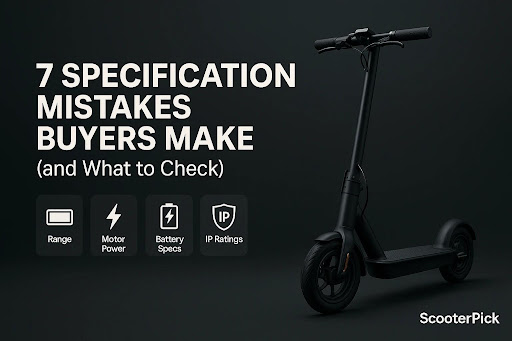7 Specification Mistakes Buyers Make (and What to Check)

Most buyers don’t make bad choices; they make fast ones. Spec sheets look clear, yet real-world riding tells a different story. This guide shows you where numbers mislead and how to verify them in minutes. As you shop, keep one tab open for Scooter so you can compare calmly and avoid costly scooter specification mistakes.
Mistake #1: Taking “Range” at Face Value
Why This Misleads
Range claims assume perfect conditions: light rider, flat ground, mild weather, and slow cruising. Your commute rarely looks like that. Headwinds, hills, stop-and-go traffic, and cold mornings all cut distance. Marketing often highlights a best-case estimate, so riders expect 20 miles and get 12. That gap frustrates buyers and hides true battery demands. Because of that, this is one of the most common scooter specification mistakes.
Data example: A scooter rated for 25 miles may deliver ~60–70% for a 190 lb (86 kg) rider on mixed terrain. That’s about 15–18 miles.
What to Check (step-by-step verification)
- Find the battery in watt-hours (Wh). If only V and Ah are shown, multiply: Wh = V × Ah.
- Estimate real range with a safety factor. Use 15–20 Wh per mile for conservative commuting math.
- Adjust for rider weight and terrain. Heavier riders or hills tend to push consumption toward 20–25 Wh/mile.
- Trim for temperature. Below 50°F (10°C), remove another 10–20% from your estimate.
- Plan a buffer. Keep 15–20% reserve for unexpected detours and battery aging.
Quick Reality Test
- Formula: Wh = V × Ah.
- Example: 48V × 10Ah = 480Wh.
- Estimate: 480Wh ÷ 20 Wh/mile ≈ 24 miles best case.
- Realism check: For a 200 lb (91 kg) rider with mild hills, assume 480Wh ÷ 25 Wh/mile ≈ 19 miles. Cold weather might push it closer to 16–17 miles. Therefore, verify specifications with this quick math to avoid scooter specification mistakes.
Mini-Checklist + Red/Green Flags
- Do: Convert V×Ah to Wh; estimate range at 20–25 Wh/mile for hills/heavier riders.
- Do: Deduct 10–20% for cold days.
- Don’t: Trust a single “up to X miles” claim.
- Green flags: Transparent Wh listing; clear test conditions.
- Red flags: “Unlimited” or vague range claims without battery data.
Mistake #2: Confusing Motor Power (Peak vs Continuous)
Why It Matters
Power numbers show two different realities. Continuous (or nominal) power is what the motor can deliver steadily without overheating. Peak power is a short burst, often for a few seconds. Controllers and battery voltage limit both. On flats, peak looks exciting. On hills, continuous power plus controller current determine whether you crawl or climb. Misreading these numbers leads to scooter specification mistakes during hill tests.
Data example: A scooter listed at 1,000W peak may only be 500W continuous. On a moderate hill, the 500W continuous figure matters far more.
What to Check
- Confirm both numbers. Look for continuous/nominal wattage and peak wattage.
- Ask how long peak lasts. Seconds, not minutes, usually.
- Controller current: Higher current (within safe limits) helps torque and hill starts.
- Rider weight caveat: A 220 lb (100 kg) rider will demand more continuous power than a 150 lb (68 kg) rider.
Simple climb test: If you can, ride a steady 6–8% grade. If speed collapses or the scooter overheats quickly, continuous power is the bottleneck—not peak.
Mini-Checklist
- Do: Prioritize continuous watts for hills and cargo.
- Do: Check controller current limits.
- Don’t: Choose by peak power alone.
- Green flags: Clear continuous and peak listings.
- Red flags: Only one big watt number with no context.
Mistake #3: Ignoring Battery Specs (Voltage, Capacity, and Cells)
Why It Matters
Voltage affects speed potential and torque feel. Amp-hours (Ah) describe capacity. Watt-hours (Wh) combine both into usable energy. Cell quality and configuration affect performance, voltage sag, and longevity. Skimming voltage and Ah without converting to Wh causes scooter specification mistakes that show up in range, acceleration, and charger choice.
Data example:
- Wh: 48V × 10Ah = 480Wh (energy).
- Charger: 54.6V × 2A ≈ 110W output (approx.).
- Charge time: 480Wh ÷ 110W ≈ 4.4 hours (plus ~10% overhead ≈ 4.8 hours).
What to Check
- V vs Ah vs Wh: Convert to Wh for apples-to-apples energy comparison.
- Charge rate basics: Charger watts = output volts × amps.
- Safe charger output: Stay within recommended amperage to avoid heat and premature cell wear.
- Charge time estimate: Wh ÷ charger watts, then add ~10–15% for taper.
Mini-Checklist
- Do: Compare usable energy in Wh across options.
- Do: Verify charger voltage matches pack voltage.
- Don’t: Overlook charge rate; extreme fast charging shortens life.
- Green flags: Transparent Wh and recommended charge current.
- Red flags: No Wh listed; vague “fast charge” claims.
Mistake #4: Brakes, Tires, and Stopping Distance
Why It Matters
Speed feels fun until you need to stop. Brake type, rotor size, tire compound, and tire diameter decide stopping distance. Hydraulic disc brakes usually deliver stronger, more consistent modulation than mechanical. Electronic braking helps on the rear but rarely replaces a physical brake. Meanwhile, tire choice affects grip on wet paint lines and rough asphalt. Overlooking this mix leads to safety-critical scooter specification mistakes.
Data example:
- A scooter at 20 mph (32 km/h) might need 20–30 ft (6–9 m) to stop with quality disc brakes on dry pavement. Worn pads, low tire pressure, or wet surfaces can increase that to 35–45 ft (11–14 m).
What to Check
- Brake system: Hydraulic vs mechanical vs electronic; look for two physical brakes.
- Rotor sizes: Larger rotors (e.g., 140–160 mm) improve leverage and heat handling.
- Tires: Pneumatic for grip and comfort; solid for puncture resistance.
- Diameter: 10 in (25.4 cm) tires roll potholes better than 8 in (20.3 cm).
At-home stopping test: On dry, straight pavement, mark a start cone. Ride at 15 mph (24 km/h). Brake firmly but smoothly. Measure stopping distance several times. If distances vary wildly, inspect pads, rotors, tire pressure, and lever feel.
Mini-Checklist
- Do: Prefer two mechanical brakes; hydraulic when possible.
- Do: Check rotor size and pad condition.
- Don’t: Rely on e-brake alone.
- Green flags: Consistent lever feel, straight stops.
- Red flags: Squeal, fade, or long, wandering stops.
Mistake #5: IP Ratings and Weather Assumptions
Why It Matters
IP ratings describe lab tests against dust and water ingress. However, these tests don’t simulate weeks of road spray, winter salt, or aggressive hose jets unless stated. IP54 and IP55 suggest limited water resistance. IPX6 suggests stronger water jets tolerance, yet connectors, displays, and charge ports may still be vulnerable. Riders misread these labels and ride through deep puddles—classic scooter specification mistakes that end in corrosion.
Data example:
- IP54: Splashes from any direction.
- IP55: Low-pressure jets.
- IPX6: Higher-pressure jets.
None of these certify immersion. Wheel spray and capillary action can still find gaps.
What to Check
- Real-world guidance: Treat all ratings as “wet-road cautious,” not “storm-proof.”
- Storage basics: Dry the scooter after rain. Leave it unfolded briefly so water can drain.
- Charge only when dry: Moisture + charging equals risk.
- Cable/port inspection: Ensure gaskets and caps close firmly.
Mini-Checklist
- Do: Ride slower and brake earlier on wet roads.
- Do: Wipe down and dry connectors after rain.
- Don’t: Ride through standing water or wash with high-pressure jets.
- Green flags: Clear rating plus practical care tips.
- Red flags: “Waterproof” claims without detail.
Mistake #6: Weight, Portability, and Fold Mechanisms
Why It Matters
Weight on a page isn’t weight on a staircase. A 35 lb (15.9 kg) scooter feels light in a hallway yet heavy by the fourth floor. Folded size also matters for trunks, elevators, and bus aisles. The latch, stem design, and hinge play affect both safety and carry comfort. Buyers who skip a lift test often make avoidable scooter specification mistakes about portability.
Data example:
- Carry math: A 42 lb (19.1 kg) scooter up three flights is ~90–120 seconds of awkward lifting. Do it twice daily, and fatigue sets in fast.
What to Check
- True carry test: Lift with one hand at the deck center or a built-in handle.
- Fold speed: Time the fold/unfold. Under 10 seconds feels smooth for commuters.
- Latch robustness: Look for play at the stem clamp; minimal flex is safer.
- Folded dimensions: Measure trunk opening, then compare length/height.
Mini-Checklist
- Do: Practice a safe lift; check balance.
- Do: Verify latch tolerances; tighten if adjustable.
- Don’t: Assume “lightweight” fits your body or stairs.
- Green flags: Solid latch, low stem play.
- Red flags: Rattles, loose clamps, finger-pinch hinges.
Mistake #7: Controller, Ride Modes, and Safety Features
Why It Matters
Controllers shape throttle response, acceleration curves, and regen strength. Ride modes cap speed and current for safety and range. Electronic ABS varies by implementation; some systems pulse regen, others modulate hydraulic pressure. Lighting specs look simple but beam focus and cutoff determine visibility without glare. Skimming these details produces scooter specification mistakes that affect daily safety.
Data example:
- Mode math: If Mode 1 caps speed at 12 mph (19 km/h) and current at 40%, your 480Wh battery may stretch an extra 15–20% compared to unrestricted riding.
What to Check
- Throttle mapping: Smooth starts reduce wheelspin and strain on the drivetrain.
- Regen/ABS nuances: Check if regen strength is adjustable and whether ABS interacts with mechanical brakes.
- Traction aids: Look for sensible acceleration limits in wet mode.
- Lighting: Seek a forward beam with usable cutoff; bright does not equal focused.
Mini-Checklist
- Do: Test each mode on the same route and note energy use.
- Do: Set regen to a comfortable, predictable level.
- Don’t: Max out power in rain or cold.
- Green flags: Adjustable modes and clear lighting specs.
- Red flags: Abrupt throttle, blinding flood beams.
Specs Decoder Table
| Spec | What It Really Means | How to Verify | Good Range (Commute) | Good Range (Hills/Heavy Riders) |
| Top speed | Controller-limited max on level ground | GPS app on a flat loop | 18–22 mph (29–35 km/h) | 15–20 mph (24–32 km/h) |
| Range | Usable energy ÷ consumption | Wh ÷ 20 Wh/mi; subtract 10–20% for cold | 15–25 mi (24–40 km) | 10–18 mi (16–29 km) |
| Motor power (cont./peak) | Sustained vs burst power | Confirm both figures; test a steady hill | 350–700W cont. | 500–1000W cont. |
| Battery (V/Ah/Wh) | Voltage × capacity = energy | Convert V×Ah to Wh | 36–48V, 360–600Wh | 48–52V, 500–800Wh |
| Charger output | Charge rate in watts | Volts × amps; Wh ÷ W ≈ hours | 2–3A on 36–48V packs | 3–4A on larger packs (if approved) |
| Brakes | Stopping power and control | Two physical brakes; rotor size | Dual disc or disc + drum | Hydraulic disc preferred |
| Tires | Grip, comfort, puncture resistance | Size, pneumatic vs solid | 9–10 in pneumatic | 10 in pneumatic, tougher compound |
| IP rating | Lab splash/jet tolerance | Treat as “rain-aware,” not immersion | IP54+ with care | IP55–X6 with extra care |
| Weight | True carry burden | Lift test; stair simulation | ≤ 40 lb (18 kg) | ≤ 50 lb (23 kg) if stronger rider |
| Folded size | Trunk/elevator fit | Measure length/height vs space | Compact, folds <10 s | Compact + rigid latch |
| Lighting | See and be seen | Focused beam + rear + side reflectors | Focused headlight + tail | Add side visibility where possible |
Use this table as your quick shield against scooter specification mistakes while you compare options.
How to Cross-Check a Spec Sheet in 5 Minutes
- Convert speed units. 20 mph ≈ 32 km/h; 18 mph ≈ 29 km/h. Know your comfort zone.
- Turn V×Ah into Wh. Example: 48V × 10Ah = 480Wh.
- Estimate range. 480Wh ÷ 20 Wh/mi ≈ 24 miles; subtract 10–20% if it’s cold.
- Check continuous power. If only peak is listed, assume continuous is ~50–70% of that.
- Scan brakes and tires. Look for two physical brakes and 9–10 in pneumatic tires.
- Confirm charger math. 54.6V × 2A ≈ 110W; 480Wh ÷ 110W ≈ 4.4 hours (plus taper).
- Lift once. If 45 lb (20.4 kg) feels awful in the store, stairs will feel worse.
- Review modes and lighting. Try eco mode on your route; assess beam focus at night.
- Re-read IP claims. No rating equals dry-day only; IP54+ still needs care.
- Compare notes with a reality check. Then consult one long-form, hands-on perspective in Scooter Reviews to see how numbers behave outside the lab.
These steps reduce scooter specification mistakes because they translate data into daily riding.
When “More” Isn’t Better
Bigger numbers can hide trade-offs. More peak power draws more current and may shorten range. A heavier frame rides stable at speed, yet it punishes your back on stairs. Wider tires add comfort but mute agility in tight bike lanes. Meanwhile, massive batteries boost range yet extend charge times and raise cost. Balance matters, or you’ll repeat common scooter specification mistakes.
Think in use-cases. If you ride five flat miles each way, you don’t need 40 mph (64 km/h) capability and a 70 lb (31.8 kg) frame. Instead, prioritize efficient motors, 9–10 in pneumatic tires, dual brakes, and clear lighting. Conversely, if your route includes hills, continuous power and higher voltage help far more than headline top speed. Finally, protect your budget by matching battery size to actual miles, not fantasy ones.
When you weigh benefits against costs, you avoid scooter specification mistakes that look impressive on paper but disappoint on pavement.
Final Pre-Purchase Checklist
Use this list the day you decide. It synthesizes the “What to Check” steps so you can avoid last-minute scooter specification mistakes.
- Convert V×Ah to Wh; estimate range at 20–25 Wh/mi if you’re heavier or ride hills.
- Confirm continuous power and controller current, not just peak.
- Match top speed to your comfort and local path speeds.
- Choose two physical brakes; hydraulic if possible.
- Prefer 9–10 in pneumatic tires for grip and comfort.
- Verify charger watts; estimate time as Wh ÷ W plus ~10–15%.
- Check IP rating and plan wet-day care; never assume immersion tolerance.
- Lift the scooter once; count stairs and transfers in your commute.
- Inspect fold latch; test unfold speed and stem play.
- Evaluate lighting focus; don’t rely on lumens alone.
- Test ride modes for throttle smoothness and regen feel.
- Finalize choices with the structured specs in Scooter Specification to ensure nothing crucial is missing.
Check each box, and you’ll sidestep lingering scooter specification mistakes before money leaves your wallet.
TL;DR
- Range: Convert to Wh and divide by 20–25 Wh/mi; trim for cold. That avoids range-estimate scooter specification mistakes.
- Power: Continuous watts matter on hills; ignore peak hype.
- Battery: Voltage + capacity = Wh; use Wh for fair comparisons.
- Brakes/Tires: Dual physical brakes and 9–10 in pneumatic tires cut stopping distance and boost control.
- IP Rating: Splash-resistant is not submersible; dry and store with care.
- Portability: Weight and latch quality decide daily comfort, not brochure adjectives.
- Controller/Modes: Smooth throttle, adjustable regen, and focused lighting improve safety and efficiency while preventing scooter specification mistakes.
Mistake-by-Mistake Data Recap (for quick math)
- Range: 48V × 10Ah = 480Wh; 480Wh ÷ 25 Wh/mi ≈ 19 miles.
- Power: 1,000W peak often ≈ 500–700W continuous; hills expose the truth.
- Battery/Charge: 480Wh ÷ 110W charger ≈ 4.4 hours (+ taper).
- Stopping: 20 mph (32 km/h) to zero can be 20–30 ft (6–9 m) on dry pavement with good discs.
- IP: IP54/55/X6 ≠ immersion; dry before charging.
- Portability: 42 lb (19.1 kg) + stairs twice a day = fatigue.
- Modes: Eco caps speed/current and can extend range 15–20% on some routes.




